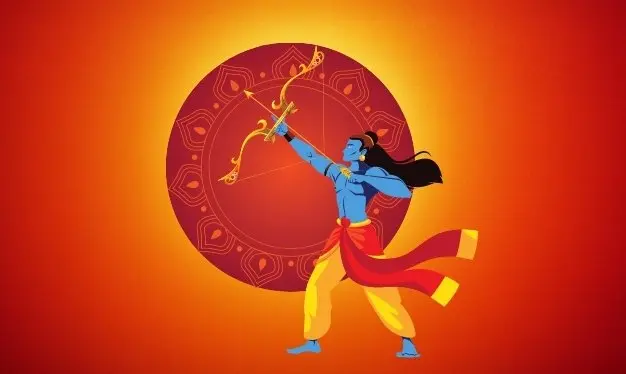
Ram Navami Special: “Pragat Hue Mere Raghurai – Sabko Badhai Ho Badhai!!”
By: Rajendra Kapil
On the sacred occasion of Ram Navami, the joy of Shri Ram’s divine birth has reached a peak across the global Sanatan Hindu community. From India to every corner of the world where Ram bhakts reside, preparations are in full swing. Homes and temples are being adorned, and hearts are filled with festive spirit. With Chaitra Navratri culminating in Ram Navami, the celebration feels truly auspicious, like the golden touch to an already sacred time. Spring is casting its vibrant energy everywhere, and the divine aura of Ram’s birth magnifies it manifold.
According to Ramcharitmanas, there are three main reasons for Bhagwan Ram’s incarnation:
- To fulfill the boon granted to the pious couple Manu and Shatarupa
- To bring to fruition the curse given by the great devotee Narad
- To destroy evil beings like Ravana
Even in the Bhagavad Gita, Bhagwan Krishna proclaims:
Yada yada hi dharmasya glanir bhavati Bharata,
Abhyutthanam adharmasya tadatmanam srijamyaham.
Paritranaya sadhunam vinashaya cha dushkritam,
Dharma-sansthapanarthaya sambhavami yuge yuge.
“Whenever righteousness declines and unrighteousness rises, I incarnate to protect the good, destroy the wicked, and reestablish dharma.”
In the Bal Kand of Ramcharitmanas, we find the tale of King Dasharath, who longed for a son even into middle age. Troubled, he sought guidance from Guru Vashishtha, who advised him to perform the Putreshti Yagya, conducted by Rishi Shringi:
Ek baar bhootpi man maahi, bhayi galani more sut naahi
Gur grih gayo turat mahipala, charan laag kari binay bisala
Shringi rishi-hi Vashishtha bulava, putra kaam subh yagya karava
Bhakti sahit muni aahuti deenhē, pragatē agini charu kar leenhē
Rishi Shringi performed the yagya with devotion. By Agnidev’s grace, a divine bowl of kheer appeared, which he offered to the king with instructions to distribute it appropriately among his queens. King Dasharath followed the command:
Ardh bhaag Kausalyahi deenha, ubhay bhaag aadhe kar keenha
Kaikeyi kahin nrip so dayau, rahyo so ubhay bhaag puni bhayau
Half went to Mata Kaushalya, a quarter to Mata Kaikeyi, and the remaining quarter was divided in two and given to Mata Sumitra. By divine grace, all three queens conceived, bringing immense joy to Ayodhya. Even the gods celebrated, showering blessings upon the land.
Ja din te Hari garbhahi aaye, sakal lok sukh sampatti chhaaye
Mandir mah sab raajahi rani, sobha sheel tej ki khani
Then came that sacred day, when all four princes were born:
Naumi tithi madhumaas puneeta, sukl pachh abhijit Haripreetaa
Madhy divas ati sheet na ghaama, paavan kaal lok bishraamaa
It was the ninth day of the holy month of Chaitra, during the auspicious Abhijit muhurta, at noon. Neither too cold nor too warm—a perfect moment. In the divine city of Ayodhya, Bhagwan Ram took birth, followed by his brothers Bharat, Lakshman, and Shatrughna. The skies were filled with gods showering flowers, and the city resounded with joyous music. People took to the streets dancing and singing.
Even Saint Tulsidas could not hold back his joy and composed this beloved stuti:
Bhaye pragat Kripala, deen dayala, Kaushalya hitkari
Harshit Mahatari, muni man haari, adbhut roop nihari
Lochan abhirama, tanu ghanshyama, nij aayudh bhuja chaari
Bhushan banmala, nayan bisala, shobha sindhu kharari
Kah dui kar jori, astuti tori, kehi vidhi karoon ananta
Maya gun gyanateet amana, Ved Puran bhanta
Karuna sukh sagar, sab gun aagar, jehi gaavahi Shruti santa
So mam hit laagi, jan anuragi, bhayau pragat Shrikanta
Even the Vedas declare that this Lord, who resides in every atom of the universe, has now appeared before Kaushalya in the form of a child! The mother is overwhelmed. As divine knowledge overcomes her motherly instincts, Ram gently smiles, removing the veil of wisdom and reawakening her maternal love.
Upja jab gyaana, Prabhu muskaana, charit bahut bhed keenh chhahe
Kahi katha suhaayi, maatu bujhaayi, jehi prakaar sut prem lahe
Maata puni boli, so mati doli, tajahu taat yah roopa
Keeje sisuleela, ati priyasiila, yah sukh param anoopa
Kaushalya begs Ram to become a baby and fill her lap with joy. Obeying, Ram transforms into a crying infant. Tulsidas declares:
Suni bachan sujana, rodhan thaana, hoyi baalak surbhoopa
Yah charit je gaavahi, Haripad paavahi, te na parah bhavkhoopa
“Those who sing this divine story will surely attain the Lord’s feet and will never fall into the worldly trap again.”
To those who question how the formless Lord could be born through a mother’s womb, Tulsidas explains:
Vipra, dhenu, sur sant hit, leenha manuj avatar
Nij ichchha nirmita tanu, maya gun gopar
“For the welfare of Brahmins, cows, gods, and saints, the Lord chose to take human form—not by compulsion, but through His own divine will.”
When the news of Ram’s birth reached King Dasharath, he was overwhelmed with joy, feeling as if he had attained bliss itself. Overcome with emotion, he began distributing gifts to all. He called Guru Vashishtha to perform the necessary rituals. Ayodhya turned into a land of celebration. Homes were decorated with flowers, rangoli, and sweet offerings.
Sarbas daan deenh sab kaahu, jehi paava raakha nahi taahu
Mrigamad chandan kunkum keechaa, machi sakal beethinah bich beecha
The lanes of Ayodhya were filled with the fragrance of sandalwood, saffron, and musk. Everyone danced and sang:
Aaj Awadh mein pragatē apne Raghurai
Sab mil gaavo mangal geet,
Badhai ho, bhai sabko badhai!
To all Ram bhakts around the world, we send our heartfelt Ram Navami wishes.
Jai Siya Ram!!